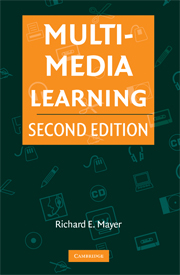Book contents
- Frontmatter
- Contents
- PREFACE
- SECTION I INTRODUCTION TO MULTIMEDIA LEARNING
- SECTION II PRINCIPLES FOR REDUCING EXTRANEOUS PROCESSING IN MULTIMEDIA LEARNING
- SECTION III Principles for Managing Essential Processing in Multimedia Learning
- 9 Segmenting Principle
- 10 Pre-training Principle
- 11 Modality Principle
- SECTION IV PRINCIPLES FOR FOSTERING GENERATIVE PROCESSING IN MULTIMEDIA LEARNING
- SECTION V CONCLUSION
- REFERENCES
- AUTHOR INDEX
- SUBJECT INDEX
- References
9 - Segmenting Principle
- Frontmatter
- Contents
- PREFACE
- SECTION I INTRODUCTION TO MULTIMEDIA LEARNING
- SECTION II PRINCIPLES FOR REDUCING EXTRANEOUS PROCESSING IN MULTIMEDIA LEARNING
- SECTION III Principles for Managing Essential Processing in Multimedia Learning
- 9 Segmenting Principle
- 10 Pre-training Principle
- 11 Modality Principle
- SECTION IV PRINCIPLES FOR FOSTERING GENERATIVE PROCESSING IN MULTIMEDIA LEARNING
- SECTION V CONCLUSION
- REFERENCES
- AUTHOR INDEX
- SUBJECT INDEX
- References
Summary
Segmenting Principle: People learn better when a multimedia message is presented in user-paced segments rather than as a continuous unit.
Example: A continuous version consists of a narrated animation on lightning formation that lasts about two and half minutes and describes sixteen steps. A segmented version consists of the same lesson, broken into sixteen segments – each containing one or two sentences and eight to ten seconds of corresponding animation – with a continue button in the lower-right corner. The next segment begins as soon as the learner clicks on continue.
Theoretical Rationale: In viewing a fast-paced narrated animation that explains the steps in a process, some learners may not fully comprehend one step in the process before the next one is presented, and thus, they may not have time to see the causal relation between one step and the next.
Empirical Rationale: In three out of three tests, people performed better on problem-solving transfer tests when a narrated animation was presented in bite-sized segments, each initiated by the learner, rather than as a continuous unit. The effect size was d = 0.98.
Boundary Conditions: The segmenting principle is most likely to apply when the material is complex, the presentation is fast-paced, and the learner is inexperienced with the material.
Information
- Type
- Chapter
- Information
- Multimedia Learning , pp. 175 - 188Publisher: Cambridge University PressPrint publication year: 2009
References
Accessibility standard: Unknown
Why this information is here
This section outlines the accessibility features of this content - including support for screen readers, full keyboard navigation and high-contrast display options. This may not be relevant for you.Accessibility Information
- 1
- Cited by
